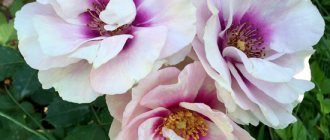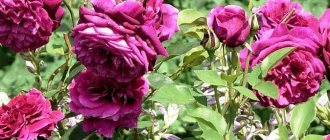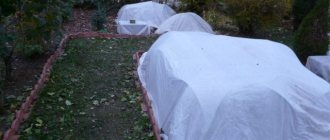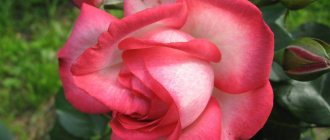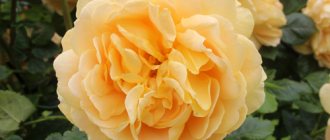Lavender ice rose is a wonderful garden plant that is quite popular among gardeners due to its amazing decorative qualities. After all, the fairly miniature bushes of this variety are decorated with beautiful flowers, as close as possible to the dream of any professional breeder - the blue rose. They are distinguished by a pleasant lavender-lilac hue and quite large size.
Rose Lavender Ice belongs to a fairly large group of rose floribunda. In turn, this variety is the result of crossing hybrid tea and other roses, which made it possible to obtain plants that are very resistant to various unfavorable conditions. For the same reason, during flowering, Floribunda roses have an incredibly attractive scent.
The emergence of the Lavender Ice variety
It is believed that the Floribunda Lavender Ice rose is the result of the painstaking work of Rosen Tantau specialists.
At the same time, they managed to complete a rather difficult task - to obtain a plant with fairly miniature bush sizes and very impressive saucer-shaped flowers. However, its main feature is its unique shade - soft lavender, with a bluish-silver tint of thin ice. This is what gave the variety its exquisite name, which can be roughly translated as “lavender ice.”
Lavender ice shade
Like many other varieties bred in the Rosen Tantau nursery, Lavender Ice (another name is the Lavender Lace rose) is distinguished by quite abundant flowering and a high degree of resistance to both pests and diseases, and to adverse weather conditions. Seedlings of this variety take root well even in the northern regions of Russia and delight owners with delicate buds that look like they came out of a fairy tale.
Features of Floribunda roses
This variety of roses includes quite a few varieties and continues to enjoy great love among gardeners (both amateurs and professionals). Moreover, many of them advise starting the development of your own rose garden with Floribunda, since it has an excellent combination of good aesthetic parameters with high frost resistance and immunity to most diseases characteristic of roses. Such qualities are associated with a very extensive pedigree of the flower - during its selection, specialists used material from hybrid tea, musk, and polyanthus roses.
Rose Lavender Ice
There are a huge number of Floribunda varieties, and each of them has a unique appearance and aroma. Among them, the miniature rose Lavender Ice deserves special attention. This variety has a relatively recent history, but at the same time it has already managed to fall in love with quite a few flower growers.
Rose El Toro: brief description, characteristics
El Toro rose flowers have petals with a terry structure and carved edges. Their color is deep red. A distinctive feature of the variety is the change in shade of the petals during flowering. They can vary from scarlet, fiery and dark orange to dark cherry color. At the end of flowering, all inflorescences have a dark burgundy color.
Appearance of hybrid tea rose El Toro
The bushes are formed straight, their height does not exceed 1 meter, and there are practically no thorns on the stems. The flowers are characterized by a cup-shaped shape, the diameter reaches 10 cm. Each flower consists of 30-40 petals. During flowering it exudes a pleasant and moderately rich aroma. If the rules of agricultural technology are observed, the crop blooms from late spring until the first frost.
Important! The El Toro variety is a frost-resistant rose that can withstand temperatures down to -25 degrees
Advantages and disadvantages of the variety
Rose Eltora, as it is sometimes called, has the following advantageous features:
- When cut, flowers and leaves do not fade for a long time.
- There are practically no thorns on the stems, which simplifies caring for the plant.
- Pleasant and unobtrusive aroma.
- Large buds are formed.
Among the disadvantages, gardeners note that the color of the petals fades in the sun, as well as the need to constantly loosen the soil, since the bushes do not tolerate stagnant moisture.
Use in landscape design
Torero rose is a real queen of the garden, which does not tolerate proximity to other plants. Bushes are planted separately or in a small compact group in combination with other varieties of roses. The rich, bright color looks great against the background of green leaves.
Using the El Toro rose in landscape design
Rose blossom
Rose Lavender, as it is sometimes called in Russian, is a repeat bloomer. It blooms en masse in early summer and several times in autumn.
The rose requires increased watering after the first flowering, during intensive shoot growth.
Close-up of Lavender Ice rose flower
From mid-May to the end of June, apply fast-acting complete fertilizers. After the last flowering, watering is reduced, the plant prepares for winter.
What to do if it doesn’t bloom, possible reasons
The rose does not bloom for several reasons:
- there was poor shelter for the winter and it froze;
- unsuitable soil;
- exposure to direct sunlight;
- insufficient watering.
You can influence flowering by changing care.
Plant care
Any profusely flowering plant requires special care. Without timely implementation of the required care procedures, the rose bush will not be able to grow and develop normally.
Well-groomed shallot bushes delight with abundant flowering
Watering rules and humidity
A very young rose bush is watered every 2 days, gradually increasing the frequency to once a week.
It is important to remember that excess moisture in the soil can lead to rotting of the roots and death of the plant.
In the spring, when the green mass is actively growing, abundant watering is also required. In summer, an adult bush is watered no more than once every 2 weeks, increasing the procedure only in hot weather.
Fertilizing and soil quality
The English rose Lady of Shalott is fed three times a season. In this case, you should adhere to the following scheme:
- At the beginning of May, nitrogen-containing and phosphorus-potassium compounds are added to promote the formation of young leaves and the development of the root system.
- After 2 weeks, when the bush begins to gain color, it is fed with potassium and phosphorus.
- 3 weeks after flowering is completed, the rose is fertilized with superphosphate, potassium salts and organic matter so that it can form flower buds for the next season.
Pruning and replanting
Spring pruning is carried out to renew the rose bush and stimulate its subsequent flowering. At the same time, I remove all dried and damaged shoots, and the remaining branches are shortened quite a bit.
The autumn procedure is designed to prepare the plant for wintering. The bush is given the desired shape, the cuts are smeared with copper sulfate, and dried leaves are removed from the stems.
Features of wintering a flower
Although the Lady of Shalott can withstand frosts down to −27⁰C, it is recommended to additionally cover it. Before wintering, the plant is sprayed with a fungicide and the soil around it is loosened. After this, the rose is spudded, covered with spruce branches and a non-woven fabric is pulled on top.
Planting and care
Grandiflora rose
The main factor in growing is the correct soil. Slightly acidic loams are best suited. To create favorable conditions for roses, you need to follow some recommendations:
- dry sandy soil is dug up with 2-3 buckets of clay and humus;
- on damp and clayey soils, on the contrary, add a mixture of humus and sand;
- also add 400 grams of lime to the planting hole;
- 500 grams of dolomite flour;
- 50 grams of superphosphate;
- 200 grams of wood ash.
If precipitation or melt water accumulates on the site, drainage is required.
Miniature roses are planted only in early spring so that the root system has time to strengthen before the onset of cold weather. During work, plants are buried 3-5 centimeters into the soil. Immediately after planting, small bushes are covered with non-woven material to protect them from the bright sun.
Care
Miniature roses require care, including watering, fertilizing and pruning bushes.
Water the plants by sprinkling twice a day in the morning and evening, but it is worth remembering that under no circumstances should the root system be flooded. In wet weather, watering is not carried out.
In autumn, after the rose has faded, watering should be reduced.
Pruning is carried out in early spring immediately after opening, and all frozen, damaged and diseased shoots are removed. The cut is made at an angle, with at least 3 buds remaining on the stem.
Feeding is carried out as follows:
- immediately after removing the cover and pruning, apply urea or ammonium nitrate under the bush;
- then, during the growth process, the fertilizer is repeated;
- as soon as the first buds appear, complex mineral fertilizers are applied;
- in August, the optimal fertilizer would be superphosphate or potassium nitrate.
The soil around the mini rose should always be cleared of weeds and well loosened.
In order for the rose to survive the winter cold well, you need to build a simple shelter:
- when preparing the bush, the remaining flowers and peduncles are removed;
- cover with spruce branches;
- then they build a wire box, which should be 20-30 centimeters higher than the plant itself;
- Insulation is first laid on the frame and then covered with film.
- All preparatory work should be carried out after frost.
It is necessary to cover miniature roses with the onset of stable cold weather. In early spring, the rose begins to be ventilated, opening the side part of the film. The shelter can be completely removed as soon as the snow melts.
Plant characteristics
This variety was obtained by crossing tea and polyantha roses. The history of the flower is connected with the name of the Danish breeder Svend Poulsen, the founder of the famous company Poulsen Roser and the creator of a new garden group of floribunda roses.
Blooming Rumba
Description of the bush
Grows up to 1-1.5 meters in height and up to 0.5 meters in width. The shoots are numerous, with dark green, sharp leaves. The spines are poorly developed, not sharp. Inflorescences of 3-15 buds are formed at the top.
Rose Rumba floribunda has a cheerful, cheerful color. The flower is characterized by a light pleasant aroma and a change in shades during flowering: from bright yellow with orange tips at the beginning of flowering to cream with crimson edges at the end. The diameter of the rose is 5-7 cm.
Important! One of the first to bloom, one of the last to fade. Gives two waves of flowering per season with a slight break
Advantages and disadvantages
Rumba has a number of advantages:
- catchy unusual coloring;
- continuous abundant flowering all season;
- compact bush shape;
- Widely used in landscape design.
There are also disadvantages:
- does not tolerate frosts of more than -23 degrees and frequent rains;
- susceptible to powdery mildew and black spot;
- requires preventive measures to protect against diseases.
Application in landscape design
The plant is popular in countries with warm and temperate climates.
Thanks to its catchiness, it immediately attracts attention. Rumba looks impressive both in flower arrangements and alone
It is used to revitalize lawns, borders, and garden paths. Goes well in compositions with coniferous plants. Its climbing rose variety, Rumba Climbing, curls beautifully around arches, attics, and summer gazebos.
Decoration of garden paths
Roses Lavender
The selection of modern roses is carried out in the direction of searching for bright, rich tones of flowers and unusual colors. It has not yet been possible to obtain a rose of pure blue color, but the Lavender rose pleases with tones close to blue. Its flowers are pale lilac, pinkish-lilac, lavender, silver-bluish, light purple. It appeared as a result of crossing polyanthus, musk and tea roses. From its parents, the hybrid received winter hardiness and the beauty of its inflorescences. Lavender is also characterized by abundant flowering that does not stop throughout the season. This feature is common to all floribunda varieties.
Rose Lavender Ice - what kind of variety is it
Rose Lavender, as it is called in Russia, was bred by breeders of the Rosen Tantau company. Experts managed to create a small miniature bush on which giant, lush buds are placed.
Border varieties of roses have always been a big favorite among gardeners
Brief description and characteristics
Rose Lavender Ice has the following characteristics:
- the height of the bush is from 30 to 50 cm, rarely the rose reaches 1 m;
- leaves are delicate green in color with a glossy surface;
- flowers up to 10 cm in diameter;
- the aroma is delicate, well expressed;
- the color of the buds is a calm shade of lavender with a silvery and bluish tint, like the surface of ice.
For your information! The name of the variety translates as “lavender ice.” Ice - not only because the color contains the cold silvery shade of the ice crust, but also because this rose is highly frost-resistant.
Advantages and disadvantages of the variety
The rose is loved by gardeners for a number of its advantages:
- ease of care;
- strong immunity that resists diseases and parasites;
- excellent decorative characteristics.
The only negative is the size and height of the bush, which limits its use in landscape design.
Use in landscape design
Lavender rose is small, so it is most often planted along borders and in open areas of the garden. It combines with other flowers, sprawling shrubs and even coniferous trees. You just need to plant it in the foreground.
Advantages and disadvantages of the variety
Rose Lavender Ice has become popular not only due to its external beauty, but also to a large number of advantages:
- ease of care;
- ability to tolerate low air temperatures;
- resistance to many diseases, in particular powdery mildew, black spot.
Rose New Fashion - characteristics of floribunda
Among the disadvantages are the small size of the bush, which significantly reduces the possibilities of application in landscape design.
This rose is planted in open areas, borders and in containers. Bushes are used in group and single plantings among the lawn, in mixborders. The rose is quite suitable for creating a hedge or diluting a row of taller shrubs.
Attention! According to the experience of Western gardeners, the Lavender Ice rose can be combined with any plants that bloom in delicate shades.
Diseases, pests and ways to combat them
The Lavender Ice rose can be attacked by insects such as aphids, roseate sawflies, and spider mites. They are controlled using acaricides and insecticides.
Rust and gray rot appear less frequently. The affected leaves are removed, the shoots are treated with iron sulfate or Bordeaux mixture.
Important! The variety is resistant to powdery mildew and black spot, which makes it extremely attractive to most gardeners. Lavender Ice can transform an ordinary plot into the most exquisite garden
Having previously studied the theory, even a novice gardener can grow a rose. Considering that this variety is not yet very common, by growing this rose you can greatly surprise other flower lovers and neighbors in the countryside
Lavender Ice can transform an ordinary area into the most exquisite garden. Having previously studied the theory, even a novice gardener can grow a rose. Considering that this variety is not yet very widespread, by growing this rose you can greatly surprise other flower lovers and neighbors in the country.
Plant care
An adult bush is undemanding and unpretentious, but the Lovely Lydia rose variety cannot be ignored. Timely watering and subsequent loosening of the top layer of soil are required to improve aeration. Fertilizing is applied in spring and summer. Sanitary cleaning of bushes and removal of faded buds are also important.
Fertilizing and soil quality
Roses are considered one of the most responsive and grateful plants for fertilizer and watering. During different periods of growth, bushes require different nutrients.
In spring, it is necessary to compensate for the lack of nitrogen for the developing vegetative mass. In summer, development requires the use of complex fertilizer with a full range of micro- and macroelements. In autumn, phosphorus and potassium are needed for better ripening of shoots.
Important! No fertilizing is needed in the first year after planting.
Pruning and replanting
The ratio between the above-ground and underground parts of the plant is regulated by pruning. But you need to trim it correctly and in a timely manner.
Ensuring long-term flowering is not easy. If the pruning is done lightly, flowering will occur early and the growths will be thin and elongated. Roses of this group bloom on the shoots of the current year. Therefore, the abundance of flowering depends on pruning.
When planting floribunda roses in spring, severe (short) pruning is used. This helps produce long, strong flower stalks for cutting. However, combined pruning is more often used:
- light pruning of stems to obtain early flowering and strong pruning for later ones;
- slight shortening is carried out in the fall;
- strong shoots on old branches are cut into rings or up to 5 buds are left. This technique opens the center of the bush.
Note! After pruning, the bushes are sprayed with a solution of copper sulfate 100 g per 10 liters of water or a 1% solution of nitrafen
Features of wintering the bush
Covering variety. They are not replanted for the winter; they are left in the ground.
Preparations for wintering begin in the fall:
- stop watering;
- stop cutting flowers.
Before the first frost, the bushes need to be covered with earth or peat to a height of 20 cm.
In October, it is recommended to carry out sanitary pruning, after which all remaining healthy shoots should be shortened to 30-40 cm. When the soil first freezes, the roses are completely covered.
Miniature roses in garden design
Miniature varieties of roses are used to decorate borders, hedges, rock gardens, and group plantings. Plants look good in flowerpots and hanging pots. The containers are located in greenhouses, on verandas and gazebos.
When planting different varieties, take into account the compatibility of shades. The most successful combinations are yellow, blue and red. White roses fit into any combination. The plant becomes the center of the composition or part of it.
Miniature varieties are placed against the backdrop of a lawn or taller plants. In multi-flowered flower beds, the rose is placed next to asters, lavender, gypsophila, and verbena. Abundantly blooming roses look advantageous against the backdrop of evergreen shrubs: barberry, thuja, cypress, juniper. Avoid combinations with bright flowers: begonias, petunias, salvia.
Growing a flower, how to plant it correctly in open ground
You can grow El Toro rose from seeds, but this is a labor-intensive process, and a favorable outcome is not guaranteed, so seedlings purchased from a specialized store are mostly used. The most suitable time for planting them is from the end of March to the end of May, when the soil is already warmed up and the likelihood of frost is low. In autumn you can also plant rose bushes in open soil. This should be done in September and October, but not later, since the planting material must take root before frost.
Appearance of a healthy rose seedling
The algorithm for planting El Toro seedlings is as follows:
A hole with approximate dimensions of 60x45 cm is dug in a suitable area. A drainage layer of expanded clay or broken stone is placed at the bottom of the hole, and a soil mixture enriched with fertilizers is poured on top. A seedling falls into a hole
It is necessary to carefully straighten the root system, and place the root collar so that it is at a level of 5-7 cm below ground level. The plant is covered with soil. It is evenly distributed between the roots; at the end the soil must be compacted a little. Water the plant generously at the root itself, avoiding moisture on the leaves or buds.
This is what a rose seedling looks like when planted in open ground
Note! If after abundant watering the soil has settled a little, then it is imperative to add some soil.
Features of growing roses Lavender Ice
Rose Lavender Ice belongs to the floribunda group of roses. The plant is able to grow well in both dry and warm climates and cool and humid climates.
It is better to choose a place for planting Lavender Ice roses so that the beauty can be seen both from the house and when simply passing by the site. This plant needs to be admired without hindrance.
Rosette will be grateful for sunny places, especially those filled with sun in the mornings or evenings. Too intense, extended sunlight can burn the petals. The place should be well ventilated, without stagnation of cold air.
Chernozem is the best soil option for planting. Loams will have to be enriched with organic fertilizers. Groundwater must be located at least a meter deep. The roots penetrate quite deeply and the proximity of groundwater leads to black spot disease.
Light acidity with a pH of 6 to 6.5 is welcome. Added peat or manure helps to acidify the soil. You can reduce acidity by using ash or by liming the soil.
You can place from 6 to 8 seedlings per 1 m2.
Planting begins in late April, early May. In autumn, planting is permissible only after allowing the seedlings to take root well before frost.
Caring for Lavender Ice consists of:
- Carrying out regular loosening of the soil around the bush, weeding.
- Disease prevention work.
- Fertilizing with nitrogen fertilizers in the spring, phosphorus and potassium fertilizers in the summer.
- Water 15–20 liters. once a week for each bush, 2 times during drought. Watering stops with the beginning of autumn.
- The first year, the emerging buds are completely removed, leaving a pair of flowers on each shoot in August.
- Full pruning in the spring (with the beginning of swelling of the buds), in the summer to regulate flowering (removing the faded inflorescence with the tip) and in the fall for prevention (sanitary pruning).
- To create a shelter when stable frosts occur at t-7C. To do this, the earth around is heaped (avoiding peat, sawdust, sand) with compost, humus or just earth. The bush is pruned. Next, everything is covered with spruce paws, a frame is installed with a gap of 0.2–0.3 m above the plant. The frame is covered with insulation, then with film (leaving air holes). Ventilation should begin in March - April. Removing the top film in the spring will speed up the appearance of buds.
Rose “Lavender Ice”:
How and where to buy roses of this variety
Nurseries and specialized rose stores are the best suppliers of Lavender Ice seedlings. The buyer is guaranteed to purchase exactly this variety, and not one similar to it. The seedlings are adapted to local climatic conditions. In addition, in nurseries and stores, customers are allowed to independently look for a young plant for the garden. Also, when purchasing a rose from a nursery, you can be sure that it was looked after by specialists and received proper care. Seedlings are sold with a closed root system in pots or special tubes, which ensures their easy survival after transplantation.
Nursery and store workers who are interested in customers will always competently advise on all the nuances of planting and caring for roses.
Lavender Ice roses are a wonderful addition to any garden. To grow a luxurious rose bush, you can only have average knowledge of growing them. Lavender Ice is easy to care for, but compares favorably with other roses with the mesmerizing beauty of its inflorescences.
Beautiful Lavender Ice from Tantau
In my review, I want to share my experience of growing a beautiful rose from Tantau. Lavender Ice is my favorite. And I grow them not in the country, but on the balcony!
I bought the flower via the Internet in joint purchases of our city. I choose seedlings of varietal roses from nurseries that have received awards and quality marks.
The most famous rose nurseries
Kordes (Germany), Tantau (Germany), Lens (Belgium), Davis Austin and Harkness (England), Guillot and Meilland (France)
Why I chose a rose from Tantau:
— German originators have achieved success in breeding varieties that are resistant to common diseases and at the same time winter-hardy;
— roses bloom almost continuously, at least two waves of flowering;
- many plants have flowers that are completely unique in shape and very densely packed
- there are dwarf varieties suitable for balconies
Features of the Lavender Ice variety:
belongs to the floribundas, a low compact bush. I’ve had the rose for three years now, during which time its height has remained around 60 cm.
The shoots are directed upward, which is important if there is not enough space on the balcony. delicate lilac color. When the heat lasts for a long time, the flowers become grayish-pink, slightly ashen. the buds do not rot in rainy weather, they just wait for the sun to bloom in three waves, as a rule
Even when Lavender Ice was attacked by mites, it still continued to bloom. Winters without problems under cover.
I call her my smart girl. No matter what happens, she always pleases with large, densely packed flowers.
The most common question I hear is “what to do with them in winter?” Since I live in Siberia, leaving roses on the balcony, even under insulation, is not an option. Severe frosts in the region of thirty degrees are not uncommon in our country, but rather the rule. In order to preserve the root system of roses, we dig them into the ground at a friend's dacha, usually at the end of October.
I will share my method of arranging roses for the winter.
— We buy covering material “Agrotex” and prepare an “air cushion”. For us, these are dry oak leaves collected in an oak grove nearby. I know that many people use spruce branches, but we feel sorry for breaking trees.
“Then I remove the leaves and remaining buds from the plants, but do not trim the branches. After all, in the spring you will have to cut off frozen shoots in any case (usually from 2 to 10 centimeters).
— A trench is dug at least fifty centimeters deep, and roses are placed in it at an angle of 45 degrees, right in the pots. Sprinkle leaves on top. Cover everything with covering material.
We usually dig up roses in late spring, around the end of April. As a rule, the branches are green and have many buds. This means that the plant has woken up and is ready for the new season.
My hobby has inspired my family and friends. And my mother began to perceive dacha work differently when joy appeared on the plot in the form of lush rose bushes.
Reproduction
Reproduction of miniature roses is carried out only by cuttings according to the following scheme:
- To carry out the work, choose powerful stems with 3-4 buds;
- Next, make a cut at an angle of 45 degrees under the bud from below, and at a right angle above the bud from above;
- The finished cuttings are kept in Epin solution (100 grams per liter of water) for 8-10 hours;
- First, drainage is laid out at the bottom of the container, then fertile garden soil is poured. At the final stage, a thin layer of sand is added;
- Then the cuttings are rooted, moistened abundantly and covered with film. They are kept in this state for a month.
As soon as the first roots appear, future seedlings can be opened and ventilated.
Brief description and characteristics
Spray rose Lydia (lat. Lydia) has the following characteristics:
- bushes are compact, 50-60 cm high, erect, densely leafy, without thorns;
- leaves are dark green, oval;
- flower color from soft pink to juicy crimson;
- goblet-shaped flowers are collected in inflorescences, one with up to 10 buds. Each such brush is already a wonderful bouquet;
- flower diameter up to 4 cm;
- Flowering is long, from early June to September.
What does Lovely Lydia look like?
For your information! The peculiarity of the variety is the dark middle of the flower.
Advantages and disadvantages
Advantages of the variety:
- valued for continuous flowering, abundant and long-lasting;
- clusters of flowers are very impressive;
- upright bush. No thorns;
- ease of care;
- frost resistance down to −23 °C;
- Rose Love Lydia has good immunity.
There is only one drawback - weak aroma.
Use in landscape design
In garden design, this low spray rose looks gorgeous in group plantings and in flower beds. The bush rose Lovely Lydia rightfully occupies a place in the foreground of the flower garden, and it is especially beautiful against the backdrop of conifers. Used as a border along paths, and in tall flowerpots it is simply irresistible. Fits perfectly into an alpine slide.
Note! Can also be grown as a cut garden crop
Characteristics of the Lavender rose
Rose Grace
This plant is an excellent choice for growing in the foreground. They can be used to decorate borders and other hills, and container growing is also a good choice. The variety is classified as a patio rose, since the bushes most often range in height from 30 centimeters to half a meter. However, there are plants that reach almost a meter mark. The foliage has a pleasant shade and glossy texture. The flowers have a delicate aroma and are quite large in size (up to 9-10 centimeters in diameter). Flowering is abundant, often occurring several times.
Blooms several times
It is not without reason that this rose has the word Ice in its name, because it is one of the cold-resistant roses. Moreover, it blooms several times during the season, and the last one often stops just before the onset of cold weather. As for stability in terms of precipitation, it is somewhat lower. A pleasant bonus for any gardener is that Lavender is not at all prone to powdery mildew or black spot.
Recommendations for cultivation
Thanks to the varietal characteristics, planting, growing and caring for this variety are quite simple. In this case, the description of all the necessary recommendations for planting seedlings is reduced to the following list:
The optimal place to place a patio rose will be an open area with a sufficient degree of illumination. In this case, it is desirable that direct sunlight falls on the plant in the morning and evening. The possibility of ventilation and the absence of cold air currents (especially in winter) are also important. The best soil for planting Lavender Ice roses is black soil.
At the same time, it is very important not to make a mistake with the groundwater level - it should be at least a meter deep from the surface of the earth. It is desirable that the soil has a slightly acidic reaction. If this is not the case, you can use such “feeding” as peat or humus. The optimal time for planting the above variety is the end of April and the beginning of May.
It is also possible to carry out this activity in the autumn, but in this case it is necessary to make all the necessary recommendations before the onset of frost on the soil so that future bushes are well rooted in the ground.
Important! In order for plants to develop properly, it is necessary to provide them with sufficient area: approximately six to eight seedlings should be planted per square meter of land. As for the rules for caring for Floribunda, they are practically no different from working with other roses
To ensure normal conditions for roses it is necessary:
As for the rules for caring for Floribunda, they are practically no different from working with other roses. To ensure normal conditions for roses it is necessary:
- Regularly loosen the soil around the bushes and weed it from weeds.
- Prevent major diseases.
- Apply nitrogen, phosphorus and potassium fertilizers in a timely manner.
- Also, do not forget about watering. To do this, it is enough to use from one to one and a half buckets of water, do it once a week, and during severe droughts - no more than two.
- Three times a year (spring, summer and autumn) it is necessary to prune the bushes. It is also necessary to remember the need to completely remove all buds in the first year. In August, no more than two flowers are left on each of the new shoots.
- With the onset of the cold season, roses are covered. To do this, the ground around the bushes is hilled up using soil, humus or compost, and the plants themselves are pruned. Next, the structure is covered with a special frame, spruce branches, insulation and film.
Note! In the process of covering the bushes, it is necessary to leave holes in the film (the so-called “vents”). Also, from March (or, depending on weather conditions, from April), the plants are ventilated, and the top layer of the film is completely removed to speed up the pipping of the buds
Wrinkled rose: description and characteristics of the plant
Rose High Magic
Wrinkled Rose
The wrinkled rose belongs to the Rosehip family and is an original shrub that perfectly complements any flower garden. The culture has a long flowering period and goes well with other plants in compositions. The most popular varieties are white, pink and red.
The plant can be found growing wild in Japan, China, and Korea. The climatic conditions of these areas coincide with the requirements of the plant. The culture is not found in its natural form anywhere else, but is artificially propagated and cultivated in almost all countries.
Note! Many varieties of wrinkled rose are highly resistant to low temperatures and prolonged frosts in winter, and are also not afraid of dryness on hot summer days. The rugosa or wrinkled rose reaches a height of 2.5 meters, has strong spreading stems, erect shoots and sharp thorns of different sizes, which are noticeable due to the contrasting red hue
The rosehip root system is powerful, develops well and goes deep to 2.5 m, branching into many small shoots
The rugosa or wrinkled rose reaches a height of 2.5 meters, has strong spreading stems, erect shoots and sharp thorns of different sizes, which are noticeable due to the contrasting red hue. The rosehip root system is powerful, develops well and deepens to 2.5 m, branching into many small shoots.
The foliage is characterized by a wrinkled surface and a bright green color. The lower part of the plate is painted in a grayish tint. The leaf length reaches an average of 22 cm. The buds begin to form individually or are grouped into clusters. The color palette varies from soft white to dark red depending on the variety. The diameter of the bud is from 6 to 12 cm.
Flowering begins in May-June, followed by the fruiting period. The fleshy yellow fruit acquires a warmer color over time and reaches an average of 3 cm in length.
On a note! In one season you can get 3-4 kg of fruits and use them for medicinal purposes, as well as in cooking.
Fruits and buds of wrinkled rose
Plant care
The soil around the plant needs to be weeded periodically. During the spring-summer period, disease prevention is carried out.
Watering rules and humidity
Rose loves moisture, so water it once a week with 15-20 liters of water.
During dry periods, watering is carried out 2 times a week.
Important! In autumn, the plant does not need additional moisture. Top dressing
Top dressing
In the spring, nitrogen fertilizers are applied to the bush, and in the summer, potassium and phosphorus fertilizers are applied.
All buds that appeared in the first year of the plant’s life are cut off, only in August several buds are left on each shoot.
In an adult plant in the spring, during the period of swelling of the buds, all the buds are cut off. In summer, only faded inflorescences are removed and the tops are trimmed.
In the fall, sanitary pruning is carried out - it involves removing diseased and dried branches.
Features of wintering a flower
Shelter is organized when the outside temperature drops below -7°C.
The soil around the bush is covered with compost (no peat, sand or sawdust is used). The shoots are pruned and covered with spruce paws.
A frame is installed around the plant, which is covered with insulation and film (with ventilation). From the beginning of March, the plant can begin to be ventilated.
Growing a flower: how to plant it correctly in open ground
The plant is very decorative and unpretentious. Flower petals do not fade in the sun and do not fade from rain.
In Russia, roses classic Lydia and Lovely Lydia are propagated by cuttings. From these seedlings are grown throughout the year.
Type of bush
The most favorable time for planting seedlings is spring.
Important! Transplanting adult bushes is more favorable for the plant in the autumn period from September to October
How to prepare the soil and flower for planting
The area for planting rose bushes should be prepared in advance. Work can begin a month before.
The main stages of preparing a landing site:
- clearing the area of weeds;
- deep digging to the height of the humus layer;
- preparing holes for planting;
- preparation of nutrient substrate for laying in pits.
Basic recommendations for preparing seedlings for planting:
- Before planting, the seedlings are pruned, stems with mechanical damage and dry branches are removed;
- shortening the root system by 1-1.5 cm;
- soaking the roots in a solution of biostimulants.
Step by step landing procedure
Patio roses, which include Lovely Lydia, are not picky, although they love black soil.
Landing stages:
- Before planting, the hole is filled with a prepared nutrient mixture consisting of turf soil, peat, sand and mineral fertilizers.
- The seedling is covered with soil strictly up to the root collar.
- Watering is carried out immediately. You need at least 10 liters per bush.
Note! The development of roses depends on the planting density. Life and longevity depend on external factors
Advantages of miniature roses
Miniature roses are a separate group that has its own characteristics. This includes low-growing varieties with a height of 15 - 25 cm. The bushes are compact, with numerous shoots. Their branches are thin and strong, with small thorns and leaves. Flowers 1 - 2 cm in size are collected in inflorescences.
Benefits of growing miniature roses:
- take up little space on the site;
- produce many inflorescences;
- flowering begins in summer and lasts until autumn frosts;
- variety of varieties;
- frost resistance;
- unpretentious to growing conditions;
- fit easily into landscape design;
- They reproduce without problems by grafting and cuttings.
Flower propagation
The bush is propagated using cuttings.
Detailed description
Cuttings are the best way to propagate roses, which preserves all the characteristics of the variety. How to carry out the procedure:
- Select branches that have buds for cuttings.
- Under the lower bud, make a cut at an angle of 45°, above the upper bud, cut at a right angle.
- Immerse the cuttings in any biostimulator for 10 hours.
- Pour fertile soil with sand into a container, lower the cuttings into it, water it and cover with film or a plastic bottle.
- Every day, ventilate the soil for 20-30 minutes.
The roots appear in about 1-1.5 months, after which the rose can be planted in another place.
Important! The root collar of the rose must be above the ground so that the stems above the graft can actively develop
Reproduction and planting
Beautiful and original Lavender roses are easy to propagate by cuttings. This simple method allows you to preserve all the characteristics of the mother plant:
- Select stems with 3-4 buds. A cut is made under the lower bud (the angle of inclination must be 45°), above the upper bud - at a right angle.
- The prepared cuttings must be kept for 10 hours in a solution of Epin or another biostimulant.
- The cuttings are placed in a prepared container with drainage, fertile soil and a layer of sand, watered well and covered with film. The roots should appear within 30-40 days, after which the seedlings are gradually opened and ventilated.
It is better to choose a place for planting plants of this group in partial shade. In this case, the flowers will not fade under the hot sun and will remain on the stems longer. You should not choose lowlands - cold air accumulates there, waterlogging is observed, which is why the plants often get sick. Before planting, the soil is fertilized and improved; not only fertilizers are added, but also sand and peat.
Rose Lavender
Important! The root collar of grafted seedlings should be above the ground level; in this case, active growth of stems above the grafting is observed
Bloom
During the season, Rumba blooms 2 times: 1st period - end of May-June, 2nd period - July-August. The dormant period is short and not noticeable, since the flowers constantly replace each other.
Note! The withered petals of Rumba do not fall off, but dry up on the bushes. For this reason, the appearance of the plant becomes untidy, and flowering weakens.
Therefore, gardeners must remove faded inflorescences in a timely manner.
Lack of flowers
In the first year of bush development, this is normal for Rumba. Otherwise, you need to establish the cause and solve the problem:
| Cause | Solution |
| Poor landing site (little sun, many drafts) | Replant the bush, remove the shadow |
| Depleted soil | Apply fertilizer |
| Trimming the bush too short | Allow the bush to develop |
Description of the subspecies
Miniature roses are also called dwarf or border roses. Initially, the history of miniature roses dates back to ancient China, from where wild shrubs were brought to Europe
And already there, in 1918, the Swiss breeder Dr. Roulette first noticed a low-growing plant with colorful buds and developed the Rouletti variety, which became the ancestor of other varieties. Dwarf plants were bred in Holland, America and Spain.
Miniature roses are characterized by low growth, long-lasting, abundant flowering
In appearance, dwarf flowers are in no way inferior to classic plants. On average, the shrub grows to 15-20 centimeters, but there are varieties whose height can be 40-45 centimeters. The buds are most often collected in inflorescences of 3-5 flowers and are distinguished by a huge variety of different colors and shapes. The crown of such a plant is very bright, dense, and consists of many small, matte leaves.
Flowering lasts throughout the season in three waves, spring, summer and autumn. Given modest shelter, the bushes can easily withstand harsh Russian winters.
Diseases, pests and ways to combat them
Lavender is a strong variety that is not prone to disease. The only thing that can happen is root rotting due to excessive watering. To restore the bush, it is necessary to remove damaged roots and normalize watering.
Lavender is ideal for those gardeners who want to highlight their plot, giving it some flair.
Aphids may attack bushes. To get rid of it, roses are sprayed with a soap solution. In advanced cases, insecticides are needed.
Lavender is a beautiful border rose with lush blooms and large delicate buds. Despite the modest size of the bush, they will create a bright accent in a flowerbed or summer cottage.
